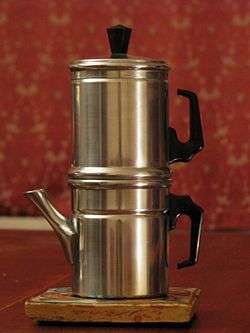Neapolitan flip coffee pot

The Neapolitan flip coffee pot (Italian: napoletana or caffettiera napoletana, pronounced [kaffetˈtjɛːra napoleˈtaːna]; Neapolitan: cuccumella, pronounced [kukkuˈmɛllə]) is a drip brew coffeemaker for the stove top that was very popular in Italy until last century. Unlike a moka express, a napoletana does not use the pressure of steam to force the water through the coffee, relying instead on gravity.
History
The napoletana is claimed to have been invented in 1819 by a Frenchman named Morize.[1][2] The reason for taking its name from the city of Naples is unknown.
Structure and use
It consists of a bottom section filled with water, a filter section in the middle filled with finely ground coffee, and an upside-down pot placed on the top. When the water boils, the entire three-part coffee maker is flipped over to let the water filter through the coffee grounds. Once the water has dripped through the grounds, the water-boiling and filter sections are removed, and the coffee is served from the remaining pot. If coarse grounds are used, the coffee is brewed quite mildly. Using very finely ground coffee in the "Neapolitan" style, this method can produce a coffee that has a stronger flavor than an automatic drip brew maker.
Classic Designs
Southern Italian Riccardo Dalisi redesigned this classic for Alessi. He began his research in 1979 and earned international attention when his design entered into production in 1987.[3] As they have come back to gain some popularity, Ilsa now also makes them in stainless steel.
See also
References
- ↑ William H. Ukers, All About Coffee, New York, The Tea and Coffee Trade Journal Company, 1922, cap.34.
- ↑ Selecting a Coffee Brewing Method
- ↑ (Italian) Biografie: Riccardo Dalisi
